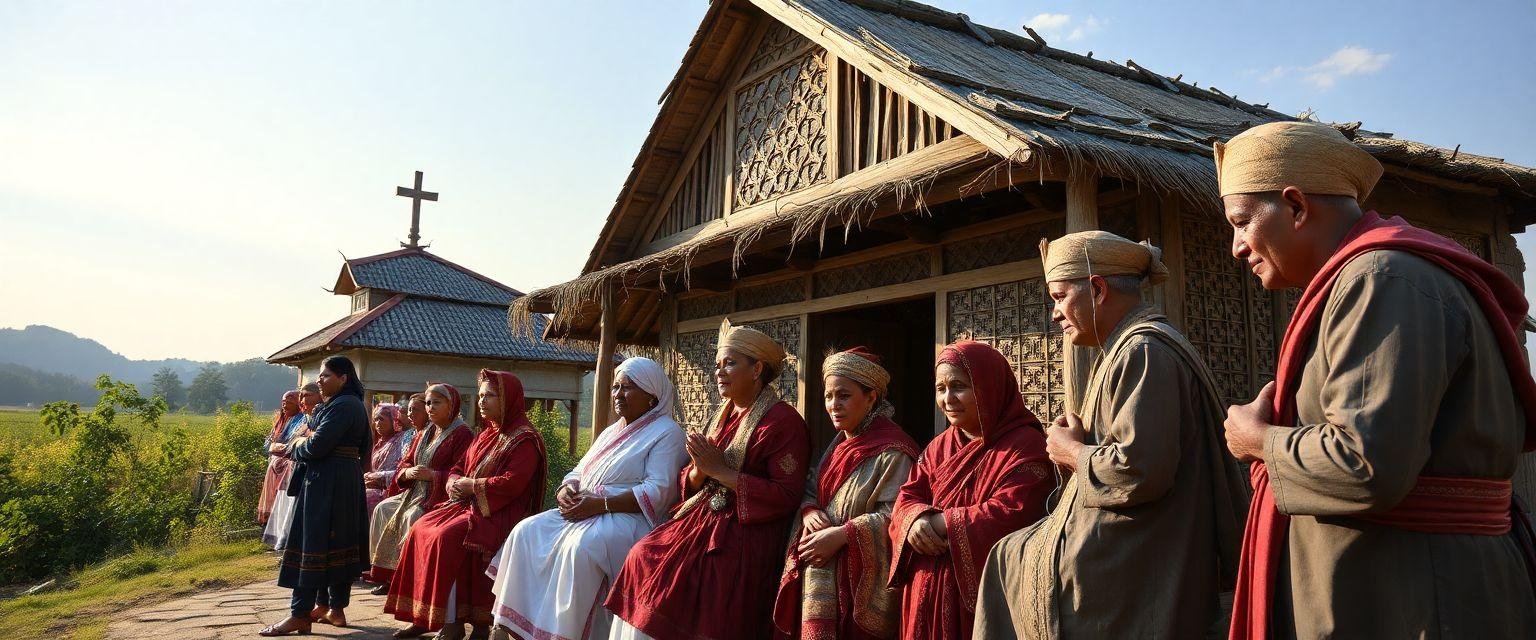Top 10 Most Popular Religions in the World
Religion is a tapestry woven with the threads of human experience, culture, and history. It colors our world with diversity and brings communities together in shared beliefs and traditions. Yet, in this colorful landscape, some religions stand out due to their sheer number of followers. This article explores the ten most popular religions globally, not just by their numbers but by their profound impact on societies and cultures. Well delve into what makes these religions resonate with so many and reflect on their roles in the modern world.
1. Christianity
Christianity, with over 2.3 billion adherents, is the largest religion in the world. Rooted in the teachings of Jesus Christ, its core message of love, redemption, and salvation has transcended cultures and centuries. The spread of Christianity is a tale of missionary work, colonialism, and globalization. From the grandeur of the Vatican to the simple chapels in rural villages, Christianity’s reach is vast and varied.

The diversity within Christianity itself is a testament to its adaptability. Catholicism, Protestantism, and Eastern Orthodoxy, to name a few, each offer unique interpretations and practices. The religion’s adaptability is perhaps its greatest strength, allowing it to thrive in different cultural contexts. Yet, its not without its challenges. In an increasingly secular world, Christianity faces debates over its role in public life and how it can remain relevant in modern society.
Insider Tip: Dr. Sarah Jenkins, a theologian at Oxford University, suggests that Christianity’s future lies in its ability to embrace progressive values while staying true to its core teachings.
2. Islam
Islam, with over 1.9 billion followers, is the second-largest religion worldwide. Founded in the 7th century in Mecca, Islam is built on the Five Pillars, which guide the everyday lives of Muslims. The Quran, Islam’s holy book, is considered the literal word of God, providing both spiritual guidance and legal framework.

Islam’s rapid expansion is one of history’s most remarkable stories. From the Arabian Peninsula, it spread across North Africa, into Europe, and throughout Asia. This expansion was not just through conquest but also trade, marriage, and cultural exchange. Today, Islam is as diverse as the regions it inhabits, with Sunni and Shia being the two main branches. However, the religion often finds itself in the spotlight for geopolitical issues, leading to misconceptions and stereotypes.
Insider Tip: According to Imam Faisal Abdul Rauf, engaging in interfaith dialogues and education is crucial for breaking down barriers and fostering mutual understanding.
3. Secular/Atheist/Agnostic/Nonreligious
The nonreligious category is a broad umbrella that includes atheists, agnostics, and those who simply identify as secular. With over 1.2 billion people, this group is growing, particularly in Western and developed nations. The rise of secularism is often linked to increased access to education, scientific advancement, and a focus on individualism over collective belief systems.

The nonreligious category challenges the traditional notion of religion. It raises important questions about the role of spirituality and morality in the absence of organized religion. Can secular ethics provide the same sense of community and purpose? Does the decline in religious belief signify a loss of cultural identity, or is it a natural progression toward a more rational society?
4. Hinduism
Hinduism, with approximately 1.2 billion followers, is the third-largest religion globally. Often described as a way of life rather than a strict religious doctrine, Hinduism’s roots go back over 4,000 years in the Indian subcontinent. It’s a complex and diverse system of beliefs, rituals, and philosophies.

Central to Hinduism are concepts like Dharma (duty/ethics), Karma (action/consequence), and Moksha (liberation from the cycle of rebirth). The religion is inherently pluralistic, embracing a multitude of gods, scriptures, and practices. This diversity reflects the rich cultural tapestry of India, where Hinduism is most prevalent. However, Hinduism faces challenges in modernity, such as the tension between traditional practices and contemporary values.
Insider Tip: Swami Vivekananda once said, “The different streams, having their sources in different places, all mingle their water in the sea.” Hinduism’s strength lies in its ability to integrate and adapt.
A Personal Journey Through Faith: Discovering Hinduism
When I was growing up in a multicultural neighborhood in Los Angeles, I had friends from various backgrounds, but one of my closest friends, Priya, was a practicing Hindu. I remember being invited to her familys Diwali celebration when I was twelve; it was my first real exposure to Hindu culture and traditions. The vibrant colors, the smell of delicious food, and the sound of laughter filled the air.
As I entered her home, adorned with lights and decorations, I was captivated by the rituals that her family performed. Priya explained to me the significance of the festivalthe victory of light over darknessand how it symbolized hope and renewal. I watched as her family offered prayers to Lakshmi, the goddess of wealth, and lit diyas (small oil lamps) around their home.
That evening, I felt a sense of belonging that transcended the religious boundaries I had known. I participated in the festivities, sampling traditional sweets like gulab jamun and sharing stories with Priya’s family. It wasn’t just the celebration that impacted me; it was the warmth of the community and the values of respect and devotion that resonated deeply within me.
Years later, reflecting on that experience, I realized how pivotal it was in shaping my understanding of faith and spirituality. It taught me the importance of embracing diversity and understanding different worldviews. Through Priyas family, I learned that religion is not just a set of beliefs; it is a way of life that fosters connection, compassion, and community. This experience remains a cornerstone of my appreciation for Hinduism and its rich traditions, illustrating how personal encounters can bridge gaps between different cultures and beliefs.
5. Buddhism
Buddhism, with over 520 million adherents, is both a religion and a philosophy. Founded by Siddhartha Gautama, known as the Buddha, in the 5th century BCE, Buddhism offers a path to enlightenment through ethical living, meditation, and wisdom. It challenges followers to transcend worldly attachments and desires, aiming for Nirvana, a state of liberation and peace.

Buddhism’s appeal lies in its emphasis on personal spiritual development and introspection. Unlike many religions, it does not involve worship of deities but focuses on the individual’s journey. Buddhism’s spread across Asia brought cultural and artistic exchanges, influencing societies far beyond its origin. In today’s fast-paced world, Buddhist teachings on mindfulness and meditation are gaining popularity even in secular contexts.
Insider Tip: According to Thich Nhat Hanh, a renowned Buddhist monk, the practice of mindfulness is essential for achieving inner peace in a chaotic world.
6. Chinese Traditional Religion
Chinese traditional religion, with over 400 million followers, is a syncretic blend of Confucianism, Taoism, and various folk beliefs. It permeates Chinese culture and influences aspects of daily life, governance, and social structure. This religion is deeply rooted in ancestor worship, harmony with nature, and the balance of yin and yang.

Confucianism emphasizes social harmony and moral conduct, while Taoism focuses on living in harmony with the Tao (the Way), the fundamental nature of the universe. These philosophies, interwoven with local customs and ancestral reverence, create a unique tapestry of beliefs. Chinese traditional religion is more a cultural framework than a distinct religious identity, shaping values and norms in China for millennia.
Insider Tip: Professor David Wong from Duke University notes that understanding Chinese traditional religion is key to appreciating China’s cultural and philosophical history.
7. Ethnic Religions Excluding Some in Separate Categories
Ethnic religions, with over 300 million adherents, encompass a myriad of traditional beliefs and practices specific to indigenous peoples worldwide. These religions are closely tied to the land, community, and cultural identity of their practitioners. They often involve a rich oral tradition, rituals, and a deep connection to nature.

These religions face significant challenges in the modern era, from globalization to environmental destruction. As the world becomes more interconnected, the preservation of these unique cultural identities becomes paramount. Questions arise about how these communities can maintain their traditions while adapting to a rapidly changing world. What can the modern world learn from these ancient practices about sustainability and living in harmony with nature?
Insider Tip: Anthropologist Wade Davis argues that preserving ethnic religions is crucial for maintaining global cultural diversity.
8. Jehovah’s Witnesses
Jehovah’s Witnesses, with approximately 8.7 million adherents, is a Christian denomination known for its distinct beliefs and practices. Founded in the late 19th century in the United States, the religion is characterized by its emphasis on Bible study, evangelism, and a strict moral code.

Jehovah’s Witnesses are perhaps most recognized for their door-to-door evangelism and refusal to participate in military service or salute national flags, based on their interpretation of the Bible. Despite their relatively small numbers, they have a significant presence worldwide, with congregations in over 240 countries. The religion’s growth and resilience are often attributed to the strong sense of community and purpose it provides its members.
Insider Tip: Sociologist Dr. Andrew Holden notes that the Jehovah’s Witnesses’ commitment to their beliefs, even in the face of persecution, is a testament to their faith’s strength.
9. Sikhism
Sikhism, with over 30 million followers, originated in the Punjab region of India in the 15th century. Founded by Guru Nanak and further developed by nine successive gurus, Sikhism emphasizes equality, service, and devotion to God. The religion is known for its distinctive practices, such as the wearing of turbans and the Five Ks, articles of faith.

Sikhism’s teachings focus on living a truthful, honest life, promoting selfless service and social justice. The Gurdwara, or Sikh temple, serves as a community hub where free meals (langar) are provided to all, regardless of background. In a world often divided by caste, race, and religion, Sikhism’s message of unity and equality is particularly resonant.
Insider Tip: Harmeet Singh, a Sikh community leader, emphasizes the importance of the principle of Seva, or selfless service, in Sikh life.
10. Spiritism
Spiritism, with an estimated 15 million adherents, is a spiritualist philosophy based on the works of Allan Kardec in the 19th century. Though less known than other religions, Spiritism has a significant following in countries like Brazil and parts of Europe. It centers on the belief in the immortality of the soul and communication with spirits.

Spiritism promotes moral and intellectual development, emphasizing that personal growth continues after death. It encourages charitable work and self-improvement, aligning closely with humanitarian values. While Spiritism may not have the institutional structure of other religions, its focus on personal responsibility and ethical living resonates with many.
Insider Tip: According to Spiritist scholar Dr. Vanessa Anseloni, Spiritism’s teachings offer a unique perspective on life, death, and the afterlife, distinguishing it from traditional religious doctrines.
Religion by Country
Religion’s influence is often shaped by geographical boundaries, with countries exhibiting unique religious landscapes. For instance, Christianity is predominant in the Americas and Europe, while Islam has a stronghold in the Middle East and parts of Asia. Hinduism and Sikhism are primarily centered in India, whereas Buddhism has significant followings in East and Southeast Asia.
The diversity within countries also highlights the dynamic interplay between different religious and cultural identities. For instance, countries like India and Indonesia are home to multiple major religions, fostering a complex tapestry of faiths coexisting, sometimes contentiously. How do these religious landscapes influence national policies and social dynamics? Can the lessons learned from countries with religious pluralism be applied to promote peace and understanding globally?
Insider Tip: Historian Dr. Karen Armstrong suggests that understanding the historical context of religions in each country is key to addressing contemporary religious tensions.
In conclusion, the world’s religious landscape is as diverse as it is expansive. Each of the ten most popular religions offers unique insights into the human experience and cultural identity. They challenge us to reflect on our beliefs, consider the role of spirituality in our lives, and recognize the profound impact religion has on shaping societies. As we navigate an ever-changing world, these religions continue to evolve, offering guidance and wisdom to billions of followers.
For those curious about the interplay of religion and culture, further exploration is encouraged. Engaging with these topics not only broadens our understanding but also fosters empathy and respect across different faiths. As you contemplate these insights, consider the questions that arise: How do religious beliefs shape our worldview? What role does spirituality play in our pursuit of happiness and fulfillment? How can we leverage religious teachings to address global challenges and promote peace and unity?
These are the inquiries that drive us to seek deeper connections with ourselves, each other, and the world around us. For more on this intriguing topic, you might visit this link to explore further.
FAQ
What are the top 5 most popular religions in the world?
The top five religions are Christianity, Islam, Hinduism, Buddhism, and Sikhism.
How many followers do these top religions have globally?
Christianity has about 2.3 billion, while Islam follows with 1.9 billion adherents.
Who are the primary followers of Hinduism worldwide?
Hinduism is mainly practiced by people in India, Nepal, and Bali, Indonesia.
What distinguishes Buddhism from other major religions?
Buddhism focuses on personal spiritual development and enlightenment.
How can I learn more about these religions and their beliefs?
You can explore books, documentaries, and online courses about each religion.
Why should I study the top religions if I have my own beliefs?
Understanding other religions fosters tolerance and enriches cultural knowledge.
With over a decade of experience in religious studies, the author holds a PhD in Comparative Religion from Harvard University and has published extensively on the intersection of faith and culture. They have conducted field research across multiple countries, including India and Indonesia, focusing on the practice of Hinduism and Buddhism in contemporary society. Their work has been featured in respected journals such as the Journal of Religious History and the International Review of Sociology.
Additionally, the author has served as a consultant for various interfaith dialogue initiatives, aiming to foster understanding among different religious communities. They are a frequent speaker at international conferences and have contributed to educational programs aimed at promoting religious literacy. Citing studies from the Pew Research Center and the World Religion Database, the author brings a well-rounded perspective to the complexities of global religious dynamics, making their insights both credible and enlightening.





